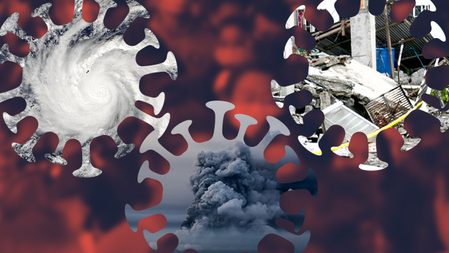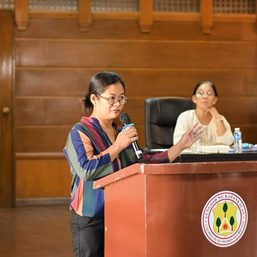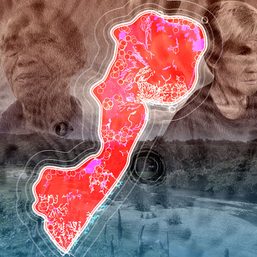SUMMARY
This is AI generated summarization, which may have errors. For context, always refer to the full article.

Are local government units prepared for arrival of typhoons during the pandemic?
In a disaster-prone country like the Philippines, which gets an average of 20 tropical cyclones annually, preparation is key to achieve zero casualty. But the response to emergencies in the face of a persisting disaster – the coronavirus pandemic – makes it more complex.
When Typhoon Ambo lashed several provinces last May, the municipality of Libon in Albay was faced with challenges in making sure that both disasters were addressed.
In an interview with Rappler, Libon’s disaster risk reduction and management officer Ian Secillano said that the health crisis has limited the capacity of the designated evacuation centers to accommodate residents because these were earlier converted into COVID-19 facilities.
Change in evacuation protocols
Libon has 15,000-16,000 families and 47 barangays, according to Secillano. Half of the population of the municipality live in houses made of light materials.
Preemptive evacuation remains to be one of their best practices during typhoons. Secillano stressed that although some residents were evacuated to their designated evacuation centers during Typhoon Ambo, others were advised to evacuate in private houses instead, especially those with special needs.
The number of evacuees in a room for each evacuation center was limited to only 60%. If a room could accommodate at least 4 or 6 families before, it was then reduced to only 2 or 3 to observe safe distances.
Evacuees were also reminded to observe health protocols such as physical distancing and wearing of protective gears.
Aside from preemptive evacuations, Secillano recalled other best practices. These include making comprehensive and contextual typhoon information and warning, and preparing communities through various training and projects in partnership with private groups, among others.
Communicating relevant information
Noting the importance of communication during disasters, the municipal government of Libon made sure to disseminate information about typhoon warnings and signals in terms understandable to its residents.
This practice has also been adapted in their pandemic response to ensure implementation of protocols for COVID-19 response by translating in Filipino information and announcements.
“Aanihin mo`yung magandang protocol mo kung hindi naman naiintindihan ‘di ba? It’s very important that you make them understand. Of course this is a health crisis so may ilang konsepto na mahirap i-Tagalog. We tried to laymanize as much as we could,” he added.
(What are you going to do with a good protocol if people do not understand it, right? It’s very important that you make them understand. Of course, this is a health crisis so there are concepts that are hard to translate in Tagalog. We tried to laymanize as much as we could.)
Combining practices
Secillano added that these practices could still be useful when typhoons strike and may still be applied in a health crisis but it has become more difficult to manage.
“We just have to combine the practices that we do for different hazards for as long as lives are not threatened, sacrificed or at risk. Mas naging mahirap siya because you have to maintain social distancing unlike before we can just talk to someone na magkalapit kayo,” Secillano said.
(It has become more difficult because you have to maintain social distancing unlike before that you could just talk to anyone near you.)
This was echoed by Pasig City disaster risk reduction and management head Bryant Wong. He said that the same protocols for disaster response would still be applied for typhoons only that the pandemic would cause a delay considering the health protocols that must be strictly followed.
“We are going to comply with the guidelines of the Inter-Agency Task Force on Emerging Infectious Diseases when it comes to COVID-19. When it comes to typhoon, it’s the application of all these. We will still have the same protocols, responses, rescue operations but of course, we need to have personal protective equipment (PPEs). This is the most vital,” Wong said in a mix of English and Filipino.
Both disaster unit heads agreed in applying their best practices in both emergencies when typhoons strike.
Partnerships during disasters
Wong said that although their procurement of disaster kits were halted to prioritize funds for COVID-19 responses, face masks and disinfectants should also be included in the disaster kit distribution.
But even the availability of PPEs has been scarce at the start of the community quarantine.
Wong added that it helped that they built partnerships with private sectors that prioritized the city for its supply of food, equipment and other needs. He emphasized the importance of having private sector support during disasters.
“We need a private sector support and we utilize it during the pandemic like ‘yung centralized quarantine facility namin sa may Rizal High school, ay karamihan ng renovation doon is private sector support na umabot ng ilang milyon. Tapos ‘yung…even ‘yung acrylic dito sa City hall, support din from the private sector rather than one to two million of acrylic, at least na-donate na lang ‘yon,” Wong said.
(We need private sector support and we utilize it during pandemic. Our centralized facility in Rizal High School, most of the renovations were made possible by private sector support that costs around millions. The acrylic glass used to protect employees in City Hall also came from the private sector. That would have cost us one to two million but it was donated instead.)
Limitations in the preparations
But the case is not always the same for all areas. Some projects and plans of the local disaster units were reprogrammed or were put on hold to prioritize programs and procurement of needed supplies to prevent and combat COVID-19.
One of the programs that they focused on during the pandemic was the establishment of psychosocial intervention or support after they recorded a number of reports from residents experiencing anxiety and depression.
To address this, Wong said they conducted seminars for psychosocial and infectious disease management to its responders. These would still be useful during typhoons especially for evacuees who might be experiencing trauma.
Another important factor when preparing for typhoons is training responders in different barangays.
Basic life support sessions were also conducted in batches as a refresher course to disaster responders but this was paused after one trainee tested reactive to COVID-19 testing last July.
In Libon, safe evacuation centers were previously planned to be put in place but Secillano said this might not happen anytime soon due to the depleted budget to address the town’s pandemic response effort.
“Our budget dwindled because of COVID-19. We even reverted some of our infrastructure projects to allot the budget to our pandemic response needs,” Secillano said in a mix of English and Filipino.
“With the pandemic, it’s like everything stopped. Kasi yung mga plano.. meron tayong plano sa isang taon and then COVID-19 happened so okay, everything was postponed or cancelled or changed, but it’s not totally lost,” he explained.
(With the pandemic, it’s like everything stopped. Because you have made plans for the year and then COVID-19 happened so okay, everything was postponed or cancelled or changed, but it’s not totally lost.)
With the rising cases in the Bicol region, responding to COVID-19 remained a priority. Secillano said they were working extra hard to maintain Libon’s zero positive case.
“We’re still responding to the pandemic and we would adjust what’s going to happen for the typhoon. We’ve been experiencing typhoons for the longest time. I think we just need to make sure a safe evacuation – that’d be our response when typhoon strikes. For as long as we have no COVID-19 cases, that is our priority for now because we really have to prevent it.,” he added. – Rappler.com
Add a comment
How does this make you feel?



![[Time Trowel] Evolution and the sneakiness of COVID](https://www.rappler.com/tachyon/2024/02/tl-evolution-covid.jpg?resize=257%2C257&crop=455px%2C0px%2C1080px%2C1080px)







There are no comments yet. Add your comment to start the conversation.